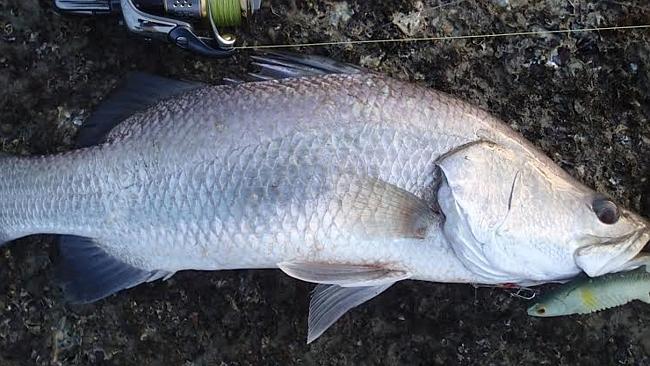
Chemical scare for barramundi. Source: Supplied
SCIENTISTS have discovered chemical pollution in Queensland’s two most high profile fish species — barramundi and coral trout.
The Great Barrier Reef discovery also marks the first time in Australia that scientists have identified feminisation of male fish.
It is not clear yet whether the contamination has human health impacts but it raises significant concerns about fisheries sustainability.
A team of 10 led by Australian Institute of Marine Science principal research scientist Frederieke Kroon found that the Reef is chronically exposed to agricultural run-off, mainly during the wet season.
“Pesticide contamination of GBR waters is … widespread and year-round,’’ the paper says.
The research is a blow to multi-million dollar programs introduced by the federal and state governments who are under pressure from UNESCO to cut Reef run-off and stem decades of damage.
Canegrowers senior environment manager Matt Kealley said there always was room to do more but the State Government’s latest report card showed that 1857 growers had improved management.
WWF spokesman Nick Heath said it was unacceptable that key species were being impacted by agricultural chemicals in a World Heritage area.
“This means the fish we eat are being exposed to chemicals in sufficient concentration that abnormalities are occurring in their genetic code,’’ Mr Heath said.
QLD Labor to spend $100 million on reef 1:25

Queensland Labor has promised $100 million to protect the Great Barrier Reef over the next five years.
- Sky News
- 14 Jan 2015
- News
“We need a far greater investment from both sides of politics in helping farmers change over to safer practices and to ensure minimum run-off and chemical contamination standards are adhered to.’’
Run-off had been regulated by the previous state government but had been replaced with a weak voluntary scheme.
Environment Minister Andrew Powell said the annual average pesticide load reaching the Reef has fallen by 28 per cent.
“We’re committed to protecting the Reef and are investing $35 million a year to improve water quality and help producers adopt Reef-friendly practices,’’ he said.
A spokesman for Federal Environment Minister Greg Hunt said 59 per cent of horticulture and 49 per cent of cane growers were improving practices.
Average pollutant loads entering the Reef had been reduced by 10 per cent for nitrogen and 11 per cent for sediment.
The scientists collected fish from nine river catchments and five reef environments, some of which had no agricultural use like the Ducie and Embley rivers on Cape York. Others — like the Haughton River on the east coast — has 98 per cent under agriculture.
Dr Kroon said the study found barramundi with abnormal levels of oestrogen compounds and exposure to run-off from cane farms was the likely pathway.
Among a long list of chemicals, the herbicides ametryn, diuron, hexazinone, simazine had been identified and the insecticide imidacloprid.
The pesticide pollution produces endocrine disrupters. These can have reproductive, neurological, immune and developmental impacts in humans and wildlife.
Most abnormal readings were found in areas where there was a high level of cane production, like the Tully, Haughton and Herbert rivers.
Dr Kroon said the next step would be to see if there would be any human health impacts.
